How an award-winning arable farm combines business and nature
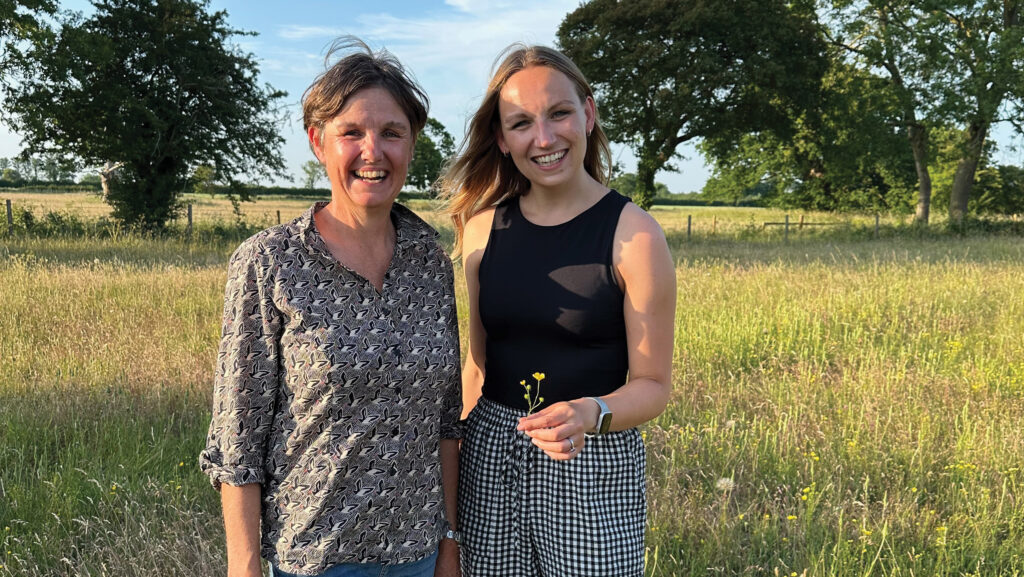 Louise Bond (left) and Florence Glover © Mike Abram
Louise Bond (left) and Florence Glover © Mike Abram Bedingham Hall Farm near Bungay is maximising its environmental conservation, while remaining committed to profitable food production.
It has done this by making full use of the natural features available on a 300ha Norfolk farm, combined with tapping into expertise.
Bruce Seaman Farms is managed by Louise Bond alongside her father Bruce Seaman and daughter Florence Glover.
It grows 250ha of wheat, barley, sugar beet and peas using regenerative farming practices such as minimum tillage and cover crops, with the help of contractors Ben and Mark Hadingham.
See also: Award-winning farmer shows ploughing can go with sustainability
Award-winning
The remaining area includes woodland, grassland and environmental stewardship areas, along with 29 ponds and almost 32km of hedgerows.
It’s the management of those areas that put the business in line to win the 2024 Ian MacNicol Memorial Trophy, awarded by Norfolk Farming and Wildlife Advisory Group (FWAG).
The award recognises farms which successfully integrate conservation measures alongside the farming business.
“Our ethos is to sustainably farm our good farmland to produce crops,” Louise explains.
“That’s very important to us as a business – while our marginal land is used for the benefit of wildlife.”
Schemes
Gaining income from environmental stewardship schemes is vital, she says. “It’s crucial – without it we wouldn’t be doing a lot of it.”
That is particularly the case currently, with low commodity prices making farming profitability a struggle.
A recently accepted Sustainable Farming Incentive (SFI) 2024 scheme, on top of a previous SFI 2023 application, has secured the business for the next three years.
This will potentially allow further work including planned river restoration.
Using the expert advice of organisations such as Norfolk FWAG, the Norfolk Wildlife Trust (NWT) and the Woodland Trust has been critical for maximising the environmental impact of existing conservation schemes around the farm.
Those experts were on hand during a recent Norfolk FWAG farm walk at Bedingham Hall Farm.
They provided tips on how the farm has enhanced natural features and used stewardship schemes for the benefit of the farm and its wildlife.
Pond restoration
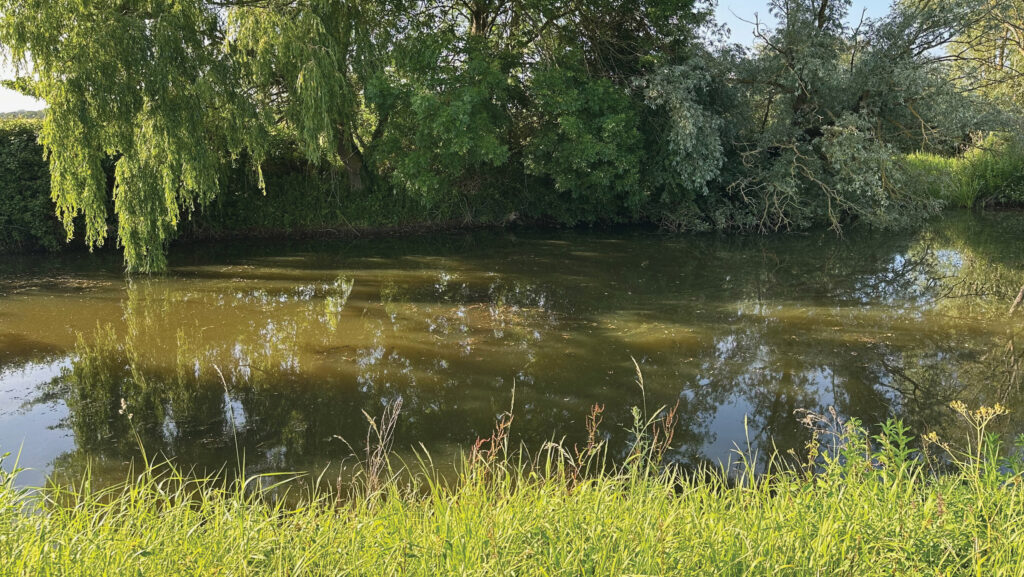
© Mike Abram
Just under half of the 29 ponds on the farms have been restored in recent years with the help of funding from NWT, Louise says.
“They have come back incredibly well, with some now having great crested newts.”
The key to encouraging wildlife in ponds is to leave the south and west sides open, allowing in sunlight, says Ben Newton, NWT landscape adviser.
“You want sunlight to reach at least two-thirds of the pond surface, which stimulates growth of plants and is then good for newts, frogs and toads, and dragonflies to lay eggs.”
Dredging ponds that have too much accumulated sediment, removing excess nutrients, will also improve plant establishment.
Ponds that are not fed with land drains or ditches will generally have better water quality, with a lower likelihood of nutrient contamination.
“Restoration can look brutal,” Ben notes. “But the speed they come back is astonishing.”
The real gold is the old sediment at the bottom, buried under leaf litter and accumulated silt, adds Ben.
“That could have viable seeds and allow plants that are locally extinct to come back.
“You need to excavate the leaf litter and nearly all of the silt – leaving perhaps just the last inch of sediment on top of the existing pond base as a potential seed source.”
Great crested newts
On Louise’s farm great crested newts have colonised restored ponds within 18 months.
“South Norfolk is a good area for great crested newts because there are lots of ponds and the habitat is well connected with lots of hedgerows,” Ben explains.
Traditionally, pond restoration has been funded through Countryside Stewardship schemes, but Norfolk FWAG farm environment adviser Henry Walker says Natural England’s district-level licensing is another option.
“To be eligible, the pond has to be currently unsuitable for great crested newts.
“We’re looking for heavily scrubbed up, shaded, silted ponds – the kind of ponds in the middle of a field, with lots of willows that barely get wet anymore.
“Restoration will let light in, take out the silt and get down to the parent material, which in south Norfolk is usually clay lined.
“Whoever is on the digger needs to be gentle to maintain the original profile of the pond. A shallow entrance provides access for wildlife to find water and drink.
“Leaving the occasional log in the pond can provide something for birds to land on too.”
The Natural England scheme can also fund restoration of “ghost ponds” – ponds that have been filled in, Ben adds. “If you have good historical maps, you can find where these are.”
But it can’t be used to create new ponds, as they are not currently a permitted development for agricultural holdings, Henry says.
“We hope an amendment in the current planning bill going through parliament will see sense and make it a permitted development.”
New woodland creation
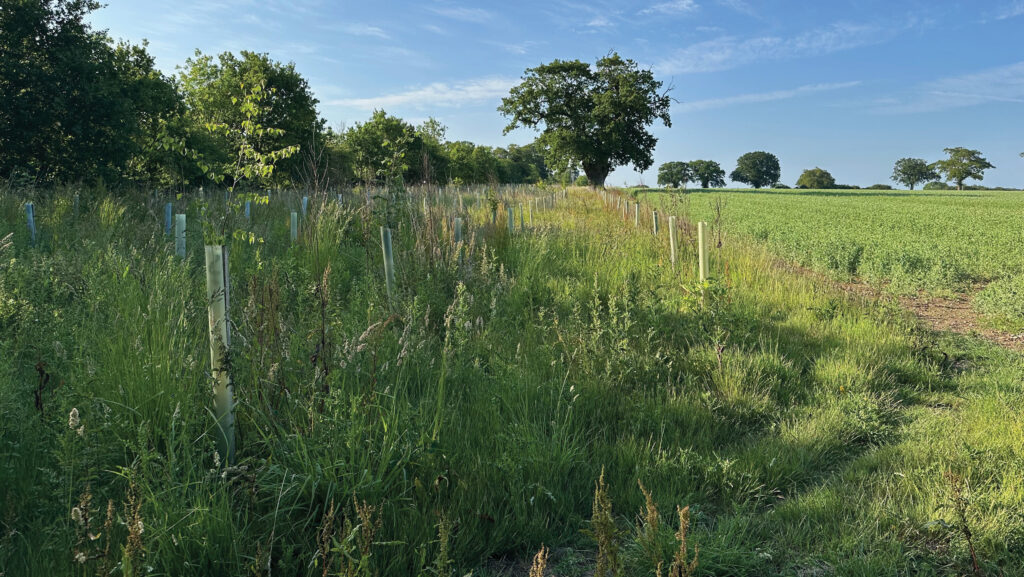
© Mike Abram
Several different areas of trees have been planted in recent years at Bedingham Hall Farm, including small-scale strips expanding and protecting existing small tree belts from arable operations, plus a larger area of woodland.
For small-scale areas of at least 0.5ha, grants covering 75% of costs, where at least 500 trees are self-planted by the farm, are available through the Woodland Trust’s MOREwoods scheme, Henry says.
“If you want to bring in contractors, it will fund 60%.”
Saplings can be provided by the Woodland Trust, although in Louise’s case she planted uncollected trees from an event run by NWT and the Woodland Trust on the farm.
This gives out 50-100 free trees for small-scale plantings.
The trees were used to border and expand an existing oak and ash tree belt.
“We decided to take this land out of arable production at the same time as restoring three ponds,” Louise says.
“Getting rid of spoil does need some thought. In this case it was spread here prior to the trees going in, which has meant quite a lot of docks and thistles, which we top out.”
A second, much larger area of woodland is being established next to ancient woodland that borders the farm.
Natural colonisation
Louise quickly understood that, in theory, she didn’t need to plant any trees and could get a free woodland through natural colonisation from seeds blown in from the neighbouring woodland.
Iestyn Griffiths, an eastern region woodland officer for the Forestry Commission, says: “Most don’t take this approach, even when they have the opportunity.”
One drawback of natural colonisation is that it can result in low species diversity, so Louise chose to do some low-density supplementary planting.
Iestyn says: “Under the England Woodland Creation Offer you can be grant-funded for natural colonisation, plus receive funding for fencing, with the only requirement that in 10 years you have a minimum of 100 stems/ha.
“On this site, I think we will have thousands of oaks, hornbeams and other trees that mean you are under less pressure to achieve a high density.”
Creating woodland using this approach typically results in a “more natural look”, he says.
“Often oaks will seed into areas in clusters, and you get field maples and cherries that will naturally put themselves on the edge.
“Often when we plant new woodlands, we dot things around and don’t get a very good end-product.
“I think here it will develop much more naturally and end with better timber.”
Protection from deer is crucial in south Norfolk, with a 2024 survey of 25,000ha in the Norfolk Broads finding on average 17 deer a sq km.
“Without a fence, we were losing all the naturally regenerating trees,” Louise says. “Which led us to try to protect some with tubes until the contractor was available to do the fence.”
Grassland enhancement
Hay meadows at Bedingham Hall Farm have been enhanced using “green” hay cut from local roadside nature reserves, as part of NWT’s Claylands Wilder Connections project.
The project aims to create new habitats and link up wildlife corridors.
Clippings from roadside nature reserves used to be fed to livestock, but with that use dwindling, FWAG and NWT, which help manage the reserves, began trialling using the green hay.
This contains a lot of seed from diverse flowering plants, to establish or restore wildflower meadows, Henry says.
“With agricultural intensification and use of selective herbicides we have lost a lot of flowering plants in meadows. But the roadside nature reserves are a great reservoir of these species,” he says.
“They contain species that flower early in the year, such as cowslips, primrose and violets, right through to species flowering through into September.”
Green hay
The meadows should be cut and baled prior to preparing the ground for the addition of seed-rich green hay.
A light surface scarification using a power harrow or set of discs opens up the sward to allow soil-seed contact when the hay is strewn, Henry explains.
“We’re now looking at how we can mechanise the spreading as it would be much more efficient,” he notes.
“After it is spread, it can be rolled or use livestock to trample out the seed.
“In subsequent years, we are looking to let everything flower to set seed before you can start using the meadow as a donor for other meadows on the farm or others.”
When restoring hay meadows, reducing the dominance of coarse grasses is crucial, Ben says.
One example of how to achieve this is the semi-parasitic species yellow rattle, which feeds off the nutrients in the roots of nearby grasses.
“There is a trade-off – species-rich hay meadows will have a lower volume of material than a ryegrass meadow. But it also has a different nutritional value and potentially a different market if you bale and sell it.”
The technique requires patience, he stresses. “It’s maybe a five-year process. I wouldn’t bank on one year and expect to see a riot of different species.
“Management can be tricky in some seasons. You don’t want to touch the meadow from April to June to let plants flower and set seed.
A method that works well is to do a hay cut in July and then aftermath graze, which is effective for increasing diversity in the meadow.”
Species-rich hay meadows can attract higher payments in environmental schemes, he adds.
Hedgerow management
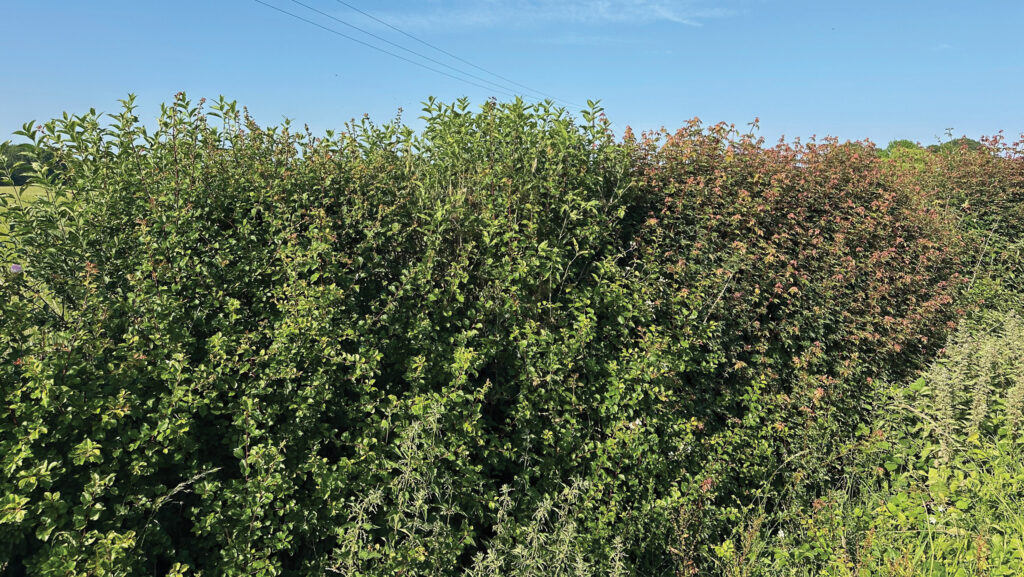
© Mike Abram
A key focus for the Claylands Wilder Connections project was hedgerows, with guidance from the People’s Trust for Endangered Species (PTES) playing a central role, Ben says.
“One of the first things we did on Louise’s farm was a survey of the hedgerows using an app developed by PTES, which helped think through next stages of management.”
Some of the hedges on the farm were quite “leggy”, with big gaps in the base, and needed restoring.
“There are two main options: hedge laying or coppicing, but once hedges get too big, hedge laying becomes harder, so we chose coppicing on this section.
“Most of it was done with tree shears or a chain saw, with the contractor cutting the hedge down to around 30cm from the floor and gaps replanted with new saplings.”
While regrowth was slower than expected because of dry weather in spring 2022, the final result has been a much better hedge with strong, dense regrowth from the base, Henry says.
“Protecting from browsing is important – deer and rabbits can kill a hedge with heavy browsing pressure. Piling some of the brash cuttings on top can help give some protection.”
The one thing Louise wishes she’d done differently is to have left some standard trees. “It was our first time coppicing and that was a little bit of an error,” she admits.
Integrating nature with farming
Analysis of historical yields from fields has helped Louise identify key areas to take land out of production, either permanently or to put into various SFI options.
The SFI agreements have extended those areas further, making use of the options for grassy field corners or blocks, and winter bird food.
In addition, the farm has been involved in a Landscape Enterprise Networks (LENs) project, which offers private funding from companies such as Nestlé, Pepsico and Anglian Water.
A field which Louise had identified as having lower productivity was chosen for the project, explains Ben Hadingham, who farms the arable area on a contract farming agreement.
“We had done various soil tests which didn’t show anything particularly amiss, so we decided we’d try a year-long cover crop funded by LENs to see whether that would improve the soil.”
What are roadside nature reserves?
Across Norfolk designated areas have been set up along roadways where verges are managed to support and enhance wildlife habitats and biodiversity.
They are often rich in wildflowers and other plants, and serve as corridors for wildlife movement and sanctuary.
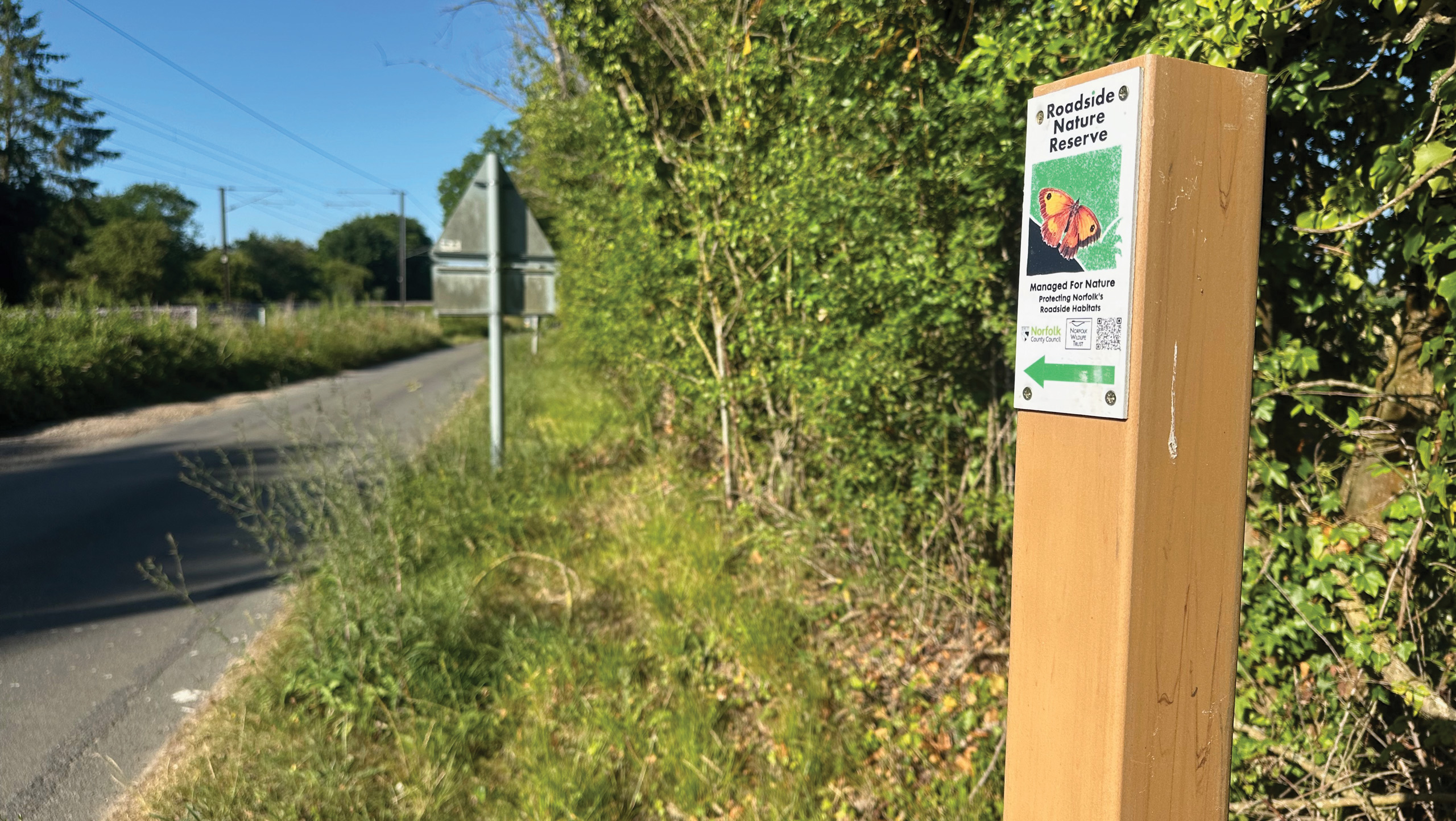
© Mike Abram
The first reserves were established in the 1990s by Norfolk County Council and the Norfolk Wildlife Trust.
They are home to rare species including spiny restharrow, pyramidal orchid, sandy stilt puffball and fragrant agrimony.
There are now more than 300 such reserves, protecting more than 100km of verge, according to Norfolk County Council.
Other counties with similar schemes include Kent, Suffolk, Bedfordshire and Lincolnshire.

